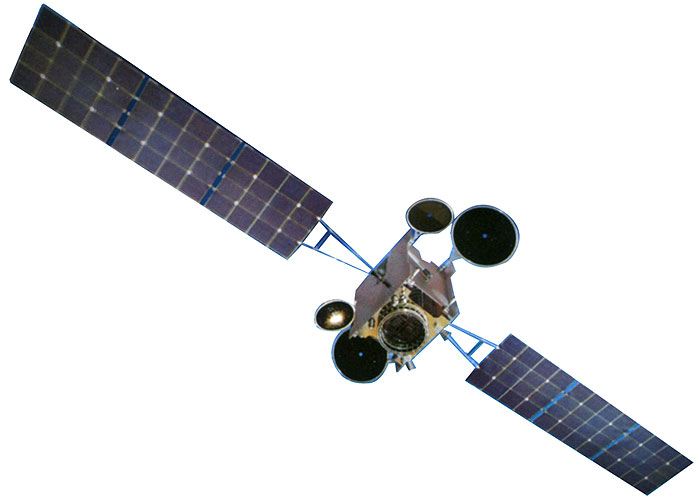|
Ekspress-1000N spacecraft platfrom In the process of improvement of the Ekspress satellite series, ISS Reshetnev introduced the Ekspress-1000N design, which was offered as a basis for Russia's domestic and foreign communications services providers. The Ekspress-1000N platform was ordered by Israeli operator Space Communication Ltd. for its Amos-5 satellite, by an Indonesian PT Telekomunikasi Indonesia Tbk for its Telkom-3 satellite and by Russian OAO Gazprom for Yamal-300K satellite. Also, the Luch-5 project used Ekspress-1000 platform. Russian Ekspress-AM8, Ekspress-AT1, Kazakh Kazsat-3 and the Ukrainian Lybid spacecraft were all based on the Ekspress-1000NT platform. (613)  |
|
||||||
Telkom-3 Telkom-3 was built by ISS Reshetnev and carried 42 transponders (including 32 C-band and 10 Ku-band) for providing commercial communications across Indonesia and Indochina. It was based on the company's Ekspress-1000N platform and was designed to function for 15 years. ISS Reshetnev also built and deployed flight control hardware for the satellite in Indonesia. The company won the tender for the Telkom-3 development in December 2008, in competition with Orbital Sciences, Thales Alenia Space and Space Systems/Loral, with the launch promised in 2011. In March 2009, ISS Reshetnev subcontracted the development of communication payload for Telkom-3 to Thales Alenia Space. Telkom-3 was insured by AlfaStrakhovanie for $7.5 million. The mission slipped from December 2011 to February and later to March 2012, however by that time it was delayed again to June 30. The launch was also advanced from July 5, 2012, but in the wake of technical problems with the launch of the SES-5 satellite and with its own Briz-M upper stage, it had to be postponed to July 25 and then to Aug. 3 and Aug. 6, 2012. Telkom-3 launch fails Following a botched launch of the Telkom-3 and Ekspress-MD2 satellite on August 6, 2012, both satellites were left in useless orbits. Nevertheless, by Aug. 10, industry sources said that some of the systems onboard the Telkom-3 satellite had been successfully activated. On August 13, ISS Reshetnev confirmed that its team had established a full control over the satellite and the spacecraft was oriented toward the Sun and its solar panels had deployed. The telemetry that was downlinked from the satellite had indicated that all its systems had functioned well, however due to a wrong orbit the practical use of the satellite would not be possible, ISS Reshetnev said. Still, the head of the company Nikolai Testoedov was quoted by RIA Novosti as saying that ISS Reshetnev could employ the satellite for testing of the Ekspress-1000N platform, which served as a basis for Telkom-3. While a test mission was under development, ISS Reshetnev was expecting to get permission for this plan either from the Indonesian owner of the satellite or from an insurance company, if the latter would take over its ownership upon paying the insurance. A Proton-M/Briz-M rocket carrying Luch-5B as a primary payload and the Yamal-300K satellite as a secondary payload lifted off from Baikonur on Nov. 3, 2012, at 01:04 Moscow Summer Time. According to GKNPTs Khrunichev, the manufacturer of the Proton rocket, the payload section including the Briz-M upper stage and two satellites separated from the third stage of the rocket and continued an autonomous flight featuring four firings of the upper stage's main engine. The separation of Yamal-300K took place at 10:18:00 Moscow Time and the separation of Luch-5B took place at 10:33:00 Moscow Time, both as planned, GKNPTs Khrunichev said. The Yamal-300K satellite and its ground control segment located in the town of Shelkovo in the eastern suburbs of Moscow was built by ISS Reshetnev for a division of the Russian gas giant OAO Gazprom kosmicheskie sistemy. It would join other satellites in the Yamal series, with a letter "K" in the name denoting city of Krasnoyarsk -- the region where ISS Reshetnev is located. The spacecraft would carry two sets of communications payloads with 26 C- an Ku-band transponders providing services across Russia and former Soviet republics from an orbital position of 90 degrees East longitude over the Equator. The design of Yamal-300K was based on the Ekspress-1000NTA platform. It was equipped with a pair of solar panels with a total area of 42.17 square meters. As of summer of 2012, the dual launch was expected at the end of September - beginning of October, but it had to be postponed from Sept. 8 by the Proton rocket failure in August. By the beginning of October, the mission was scheduled for November 3. Following its launch, Yamal-300K entered a temporary point at 54 degrees East longitude over the Equator for a series of tests. Three weeks after the launch the satellite was expected to reach an operational position at 90 degrees East longitude, where it would complement the capability of a nearby Yamal-201 spacecraft. A couple of weeks after the launch, industry sources reported problems with the control of the propulsion system onboard the Yamal-300K satellite, which required to modify onboard software, after the issue had been isolated. Ekspress-AT1 Russia's commercial workhorse rocket successfully delivered a pair of communications birds into orbit for the nation's main operator. A Proton-M/Briz-M launch vehicle lifted off from Baikonur Cosmodrome's Pad 24 at Site 81 on March 16, 2014, at 03:08 Moscow Time (7:08 p.m. EST on February 15). The rocket carried Ekspress-AT1 and Ekspress-AT2 communications satellites for Russian Satellite Communications Company, RSCC. In 2019, ISS Reshetnev got an assignment from the Angolan government to develop a replacement for the lost Angosat-1 satellite developed at RKK Energia. The Angosat-2 satellite was expected to be based on the Ekspress-1000 platform, industry sources said.
Ekspress-1000N series specifications:
|